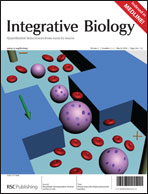Dynamics of human cancer cell lines monitored by electrical and acoustic fluctuation analysis†
Abstract
Early determination of the metastatic potential of cancer cells is a crucial step for successful oncological treatment. Besides the remarkable progress in molecular genomics- or proteomics-based diagnostics, there is a great demand for in vitro biosensor devices that allow rapid and selective detection of the invasive properties of tumor cells. Here, the classical cancer cell motility in vitro assays for migration and invasion relying on Boyden chambers are compared to a real-time biosensor that analyzes the dynamic properties of adherent cells electro-acoustically with a time resolution on the order of seconds. The sensor relies on the well-established quartz crystal microbalance technique (QCM) that measures the shift in resonance frequency and damping of an oscillating quartz crystal when adsorption, desorption or changes in material properties close to the quartz surface occur. In addition, the QCM is capable of detecting the rather subtle fluctuations of the cell bodies as an indicator for their micromotility. QCM-based micromotility readings of three different cancer cell lines (HT-29, HSC-4, FaDu) are compared with the well-known electrical cell–substrate impedance sensing (ECIS) revealing collective stochastic motion that corresponds to the malignancy of the cells.


 Please wait while we load your content...
Please wait while we load your content...